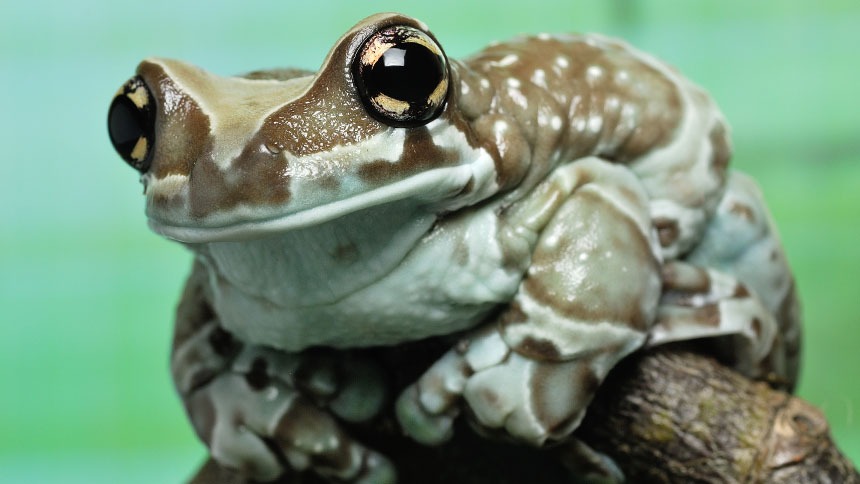
Amazon Milk Frog Care Sheet & Pet Guide
Also known as Mission Golden-Eyed Tree Frog (Trachycephalus resinifictrix)
Caring for an Amazon Milk Frog is not as hard as you may think. Choosing the appropriate size tank, cleaning a few times a week, and adjusting the climate in their habitat will ensure the well-being of your pet.
In this care guide, I’ll cover everything you need to know to properly care for a Milky. I’ll give you some tips for their setup, how to feed them, and more. My goal is to ensure you’ve got the most accurate information so you’ll have the confidence to raise healthy Amazon milk frogs as your pets.
Page Contents
Amazon Milk Frog Facts
Aside from their striking appearance, there are other interesting facts about this species you should know!
- Endemic to the Amazon Rainforest in South America
- Live for 5 – 10 years in captivity
- They’re arboreal (living in trees) and Nocturnal (sleeping during the day)
- Have a loud call, often at night
- Adults range from 2.5 – 4.5 inches in length
- Ferocious eaters
- IUCN conservation status is “Least Concern”
Complete Care Guide for Amazon Milk Frogs
In order to raise healthy Amazon milk frogs, you need to provide a habitat that reflects their natural environment. Because they’re this species is adapted to the climate of the Amazon rainforest, their enclosure should follow suit.
Proper up-keep of their enclosure is imperative. Because Amazon milk frogs are big, they produce a lot of waste. They’re messy and their droppings are acidic by nature. This means that over time, your pet’s droppings will raise the acidity level of their substrate which will eventually become harmful to them.
Due to this, regular cleaning is a must. Daily spot cleaning is encouraged and you’ll need to change their substrate (deep clean) from time to time. I’ll go into more detail about this in the substrate section.
Habitat Setup
Remember, your habitat should reflect the Amazon rainforest because that’s the region of the world milkies come from. Because they’re arboreal (living in trees), a vertical style tank is recommended. Lots of branches, plants, hiding areas, high humidity, etc.
Listed below are items I recommend for keeping these frogs as pets.
- Terrarium / Tank – To start things off, you’ll need an enclosure. Personally, I prefer glass terrariums (Exo Terra, Zoo med, Zilla, etc). A front opening terrarium is nice because it’s easy to access the whole tank. A front opening terrarium isn’t required but I definitely recommend it! A 29-gallon or 18x18x24 will comfortably hold 1 – 2 adult Amazon milk frogs.
- Substrate – A loose substrate like coco-husk fiber is great. You can also go with an ABG mix if you’re planning a bioactive setup. A full-water bottom is acceptable and so is a foam terrarium liner.
- Branches, Plants, Decorations – Lots of sturdy branches and plants will give your frogs places to climb. They should reach to the top of the habitat. Small hiding places are great too. Decorations are fine so long as they’re safe! Don’t use anything your frogs could get hurt on or stuck inside.
- Lights – Special lighting isn’t required unless its needed. Frogs needs a constant day & night cycle. This means they need light during the day. If your setup is in a room without natural light from a window, then you need a light. Should you be using live plants, I recommend getting a special grow light for plants.
- Heating – Day-time temperatures should be in the upper 70’s to low 80’s. A heating element like a UTH or heat lamp may be required depending on your situation.
- Thermometer / Hygrometer – I can’t recommend this enough. A thermometer measure the heat while a hygrometer measure the humidity. Its imperative to keep track of the environment within your frog’s enclosure so you can make adjustments as needed.
- Water Bowl – A large, sturdy water bowl with clean water.
- Cricket Keeper – The primary source of food for Amazon milk frogs in captivity are crickets (meal worms and wax worms are fine, too). But you will need somewhere to keep your feeder insects in-between feeding. You’ll also want something to feed the crickets, whether you choose cricket food from a pet store or fruits/vegetables.
- Reptile Vitamin & Calcium powder – In order to keep your pets healthy, their feeder insects should be dusted with reptile calcium and vitamins.
Terrarium / Tank
Due to their size, a tank/terrarium should be around 30-gallons. Since they’re an arboreal species, a vertical-style terrarium is beneficial.
- 18″ (width) x 18″ (depth) x 24″ (height) vertical terrarium for 1 -2 Amazon milk frogs.
I wouldn’t go any smaller than this. In fact, the bigger the better. These are large tree frogs and they enjoy their space. Even if you’re just keeping one, get a tank 18x18x24 or equivalent to 30 gallons.
Substrate
You have a number of options available for the substrate. Which substrate you choose depends on how much time you want to spend cleaning and the style or look you’re going for.
Coco husk fiber (Zoo Med’s Eco Earth) or an ABG mix are both great options. These will give you a naturalistic look. You can plant living plants in an ABG mix and expect your plants this thrive (assuming your lighting situation is correct). The downside, however, is that the substrate needs to be changed once every month or two unless you do a full bioactive setup.
A bioactive setup incorporates springtails and isopods (microfauna) to act as a clean-up crew for your frog's droppings and decayed plant matter. The only downside to a bioactive setup is that it requires more preparation and a basic understanding of what's happening in the substrate. It also prompts the need for a drainage layer since you won't be changing the substrate and this is a high-humidity environment. The excess water needs to drain below the substrate to keep the substrate from sitting in stagnant water.
A full water bottom is an option too. Because they’re adapted to high humidity, having the bottom of the tank makes sense. After all, a full-water bottom will help keep the humidity up.
The downside is you need to do water changes often. Just like with the substrate, your frog’s droppings will slowly turn the water’s pH into the acidic range.
By the way, a full-water bottom should only be implemented with adult milk frogs. Keep in mind that they still need branches and plants to climb on and there should be multiple options for climbing in and out of the water.
Foam terrarium liner or no substrate. Either one is acceptable but, like the other substrates, both have their pros and cons. The benefit of using a foam terrarium liner (or no substrate at all) is that it makes cleaning a lot easier. The major drawback is that you’re going to struggle with keeping the humidity within the recommended range.
I will say, however, that a foam liner would be better than no substrate at all. Foam will retain some water. Adding moss on top of a foam liner is something to consider as well.
Substrates like coco-husk fiber, ABG mix, and moss retain a lot of water. This helps retain humidity in the enclosure throughout the day. For more information, see my post on substrates.
Temperature
The average temperature of the Amazon rainforest is around 77° Fahrenheit (25° Celsius). The climate ranges from place to place, of course. But that’s a good number to stick to during the daytime hours. As with all environments, the temperature fluctuates from night to day and during different seasons.
- 70 – 85° Fahrenheit (21 – 29° Celsius) during the day. 65 – 70° Fahrenheit (18.5 – 21° Celsius) at night
This is just shy of what I consider “room temperature”. That is, unless you’re my parents. I visited them one day and their thermostat was set to 78 (lol). An Amazon milk frog would love their house.
Me, on the other hand, I like to keep my house between 70 – 72 Fahrenheit. In this case, providing supplemental heating is something to consider. At least during the daytime hours.
An under-tank heater will struggle to raise the temperature in a 30-gallon tank housing tree frogs. A heat lamp is more suitable for elevating the temperatures in a vertical terrarium.
Important note* 85 degrees Fahrenheit is the max. I don’t recommend going over 80. Should you decide to use a small heat lamp, use a thermometer and pay close attention to the temperature.
Getting the upper levels of the habitat around 78 degrees is sufficient. The lower levels of the enclosure will be slightly cooler because the heat bulb will be above the tank. This is what you’re looking for.
Don’t sit a heating element directly on the screen lid on top of the enclosure. Get a reptile lamp stand or secure it nicely above the tank.
With using any heating element, I highly recommend a thermostat. A thermostat is meant to turn on / turn off your heater depending on the temperature in the enclosure. Having it on a timer or smart plug is a helpful tip. A timer or smart home plug can be programmed to turn the heating element off during the nighttime hours.
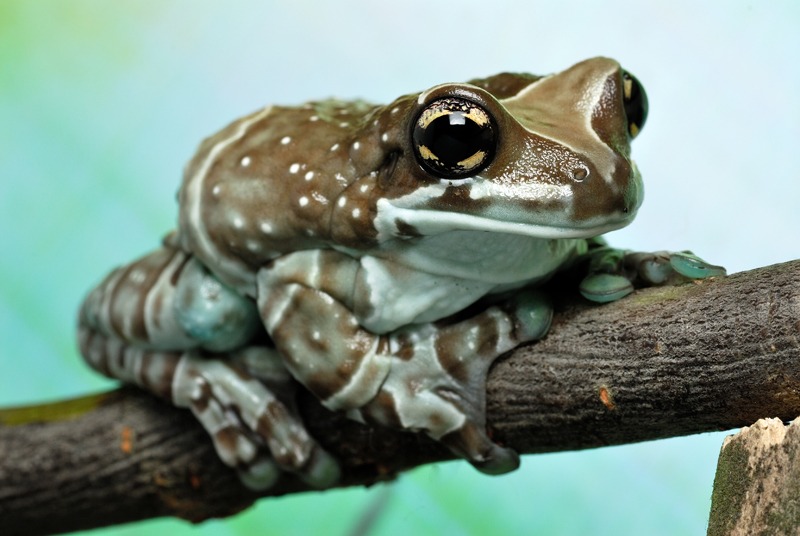
Humidity
Their natural environment is one with high humidity. Milkies tend to hang out in the mid-levels of the rainforest, nearing bodies of water. The humidity is high. Between 50% – 100% relative humidity.
- 70% – 80% humidity with highs and lows between 50% – 100%
There are natural ups and downs throughout the day. In between the rain and the way, temperature affects humidity, you can expect spikes up to 100% and lows around 50%.
You can achieve this by misting the habitat with a spray bottle throughout the day. Another way to ensure consistency is by using automated misting systems or foggers.
Again, a digital thermo/hygrometer will allow you to see what the temperature and humidity are like within your frog’s habitat. Definitely get one.
Lighting
There is much to say about lighting in the amphibian hobby. Much of it has to do with UVB, calcium, and nocturnal species. To sum this up quickly, providing low-level UVB lighting might provide benefits to amphibians in captivity.
There is not a whole lot of research on this topic yet. However, this can be negated by the usage of calcium powder supplements.
Keepers have been successfully raising Milky tree frogs for years without the use of UVB. They do, however, dust their feeder insects with reptile calcium supplement powders before feeding them to their frogs!
So why would you need lighting? Well, for a consistent day and night cycle.
- Recommended 12 hour day and night cycle. 12 hours with light and 12 hours of dark.
The day and night cycle is important. If your setup is placed in a room with lots of natural light, additional lighting isn’t required. On the other hand, a light is required if your setup is in a room with no natural light (a basement, for example).
Another reason you should consider special lighting is if you’re doing a bioactive setup with live plants. Plants need light. In fact, a special grow light would be very beneficial for the health of your plants.
Water
Your Milkies need a sturdy bowl of clean water at all times. The quality of the water is important, too.
There are several ways to ensure the quality of the water you’re using won’t have a negative impact on your frogs. RO (reverse osmosis), spring water, rainwater, or dechlorinated tap water are suitable.
Municipal tap water is almost always treated with chlorine or chloramines. The chemical treatment is to ensure no harmful pathogens survive in the water between the treatment plant and your house.
Whether or not it’s harmful to humans isn’t within the scope of this post, but untreated tap water is bad for amphibians.
Amphibians have semi-permeable skin. Simply put, whatever is in the water can find its way into your pet amphibian(s).
Hence the reason for de-chlorinating municipal tap water before filling your Milky frog’s water bowl with it. You can achieve this by aerating the water or letting it set in an open container for 24 hours. OR you can use a dechlorination agent like ReptiSafe.
Plants, Branches, and Decorations
Live or fake plants are fine! On the topic of plants, it is important to remember that adult Amazon milk frogs are large. This means you should use sturdy, broadleaf plants. Something that can support their weight.
- Provide lots of branches and sturdy plants (real or fake) for climbing and hiding
As for branches, make sure they’re secure and won’t move or fall over. The last thing you want is for your pet to get injured due to a poorly placed branch that fell over the first time you place him/her in their new home.
Cork bark tubes are great! Be mindful to purchase large cork bark tubes so when your frogs are full-grown, they can still use the tubes.
Should you decide to use any type of decoration, make sure there aren’t sharp edges or small holes in which your frog could get stuck or injured. Also, consider the materials and don’t use something which could cause a problem in a humid environment.
Feeding Your Amazon Milk Frog
Milky tree frogs are ferocious eaters. It is one of my favorite things about them. They’re large (for tree frogs) and require a decent amount of food. In captivity, you’re limited to what you can cultivate on your own or purchase from pet stores. Here is a list of common foods in their diet.
- Crickets
- Dubia Roaches
- Meal Worm
- Wax Worms
The number of feeder insects you give your frog and the frequency in which you feed them depends on their age and size.

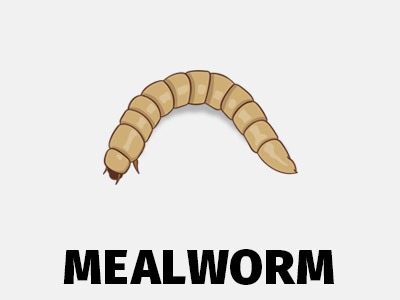
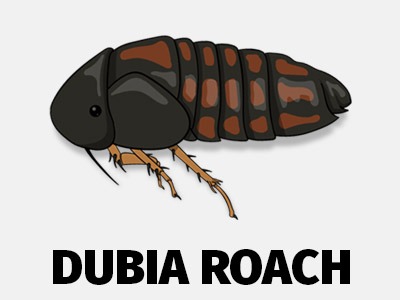
Juvenile Amazon milk frogs should be fed more frequently than adults; every day or every other day. Once matured, you can feed them 2 – 3 times per week.
The number of insects you feed them is based on their appetite and the frequency in which you feed them. Using crickets as an example. You should feed them 3 – 4 appropriately-sized crickets each feeding. If they’re eating all the crickets, increase the number of crickets by 1 each feeding until you there are leftover crickets several hours after feeding.
Also, pay attention to the size of your frog. An obese frog is unhealthy and it’s a clear indication that you need to feed them fewer crickets.
Appropriately-sized crickets
When I mention feeder insects being the “appropriate size” I’m generally referring to crickets. This pertains to worms and roaches as well, but this is easy to understand when using crickets as an example.
The way you determine the best size of crickets to feed your frog is by looking at the distance between their eyes (the frog’s eyes, ofc). Cricket should not be bigger than the distance between your frog’s eyes.
This will ensure your frog isn’t attempting to swallow something too big and getting hurt in the process.
Naturally, as your frog grows from a juvenile to an adult, it will be capable of eating larger crickets! Adjust accordingly.
Reptile Vitamins & Calcium Supplements
Because we’re limited to a handful of different feeder insects in captivity, you need to use supplements to ensure your amphibian is healthy. Feel free to read more on this topic by checking out this guide on what frogs eat.
Calcium is crucial for bone health. Remember when I said lighting and UVB is a sensitive topic in the hobby? Well, UVB helps with calcium and it’s a whole thing. Not enough research (yet) and people are understandably doing their best to care for their pets.
I said that to say this; reptile calcium powder is very important for the health of your amphibian(s). Vitamins are important, too. You can find them at local pet stores or online.
Rep-Cal and Repashy are two brands that provide these supplement powders and both have a great reputation in the community!
Handling Your Milk Frog
Amphibians don’t tolerate handling very well. We’re big, they’re small, and they get frightened easily. In addition to this, if you have chemicals on your hands, there is a good chance they will find their way into your frog. Once the chemicals are on your frog, their semi-permeable skin can absorb some of it.
It’s important to limit the amount of handling and always clean your hands.
Having said that, adult milk frogs will tolerate occasional handling. Don’t overdo it. Make sure your hands are very clean and slightly damp. Once you’re finished handling your Amazon milk frog, make sure to wash your hands with soap and water.

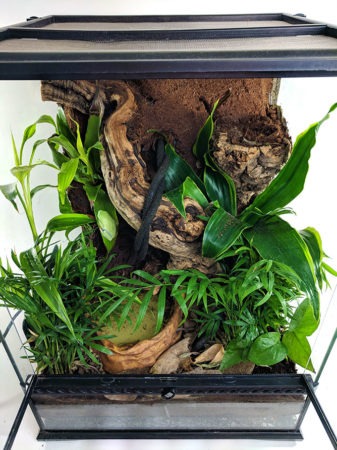
One Comment
Thank you for a concise but very informative care sheet, it’s been a great help.
Regards,
Mark.
Eco Terra set up for a Milky.🤗